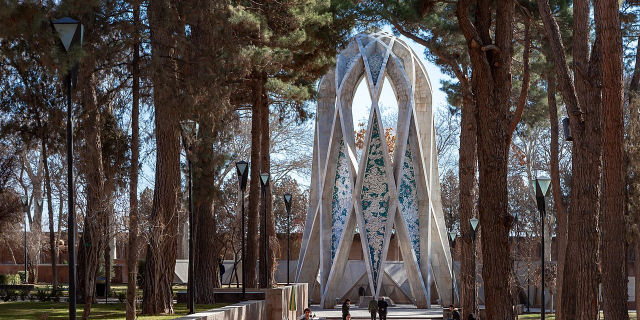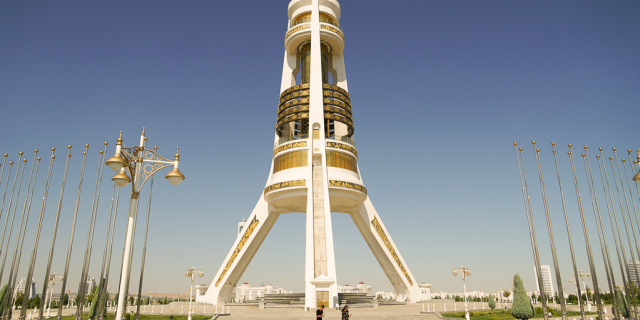حرم امام رضا
( Imam Reza shrine )The Imam Reza shrine (Persian: حرم امام رضا, romanized: Haram-e Emâm Rezâ, lit. 'Sanctuary of Imam Reza'), located in Mashhad, Iran, is an Islamic shrine containing the remains of Ali al-Rida, the eighth imam in Twelverism. It is the largest mosque in the world by area. Also contained within the complex are the Goharshad Mosque, a museum, a library, four seminaries, a cemetery, the Razavi University of Islamic Sciences, and other buildings.
The complex is a tourism center in Iran and has been described as "the heart of the Shia Iran" with 25 million Iranian and non-Iranian Shias visiting the shrine each year, according to a 2007 estimate.
The shrine itself covers an area of 267,079 square metres (2,874,810 sq ft) while the seven courtyards which surround it cover an area of 331,578 square metres (3,569,080 sq ft), totaling 598,65...Read more
The Imam Reza shrine (Persian: حرم امام رضا, romanized: Haram-e Emâm Rezâ, lit. 'Sanctuary of Imam Reza'), located in Mashhad, Iran, is an Islamic shrine containing the remains of Ali al-Rida, the eighth imam in Twelverism. It is the largest mosque in the world by area. Also contained within the complex are the Goharshad Mosque, a museum, a library, four seminaries, a cemetery, the Razavi University of Islamic Sciences, and other buildings.
The complex is a tourism center in Iran and has been described as "the heart of the Shia Iran" with 25 million Iranian and non-Iranian Shias visiting the shrine each year, according to a 2007 estimate.
The shrine itself covers an area of 267,079 square metres (2,874,810 sq ft) while the seven courtyards which surround it cover an area of 331,578 square metres (3,569,080 sq ft), totaling 598,657 m2 (6,443,890 sq ft).
Dar-ul-Imarah (Royal Residence) or the garden of Humayd ibn Qahtaba al-Ta'i was a fortress in the village of Sanabad. It dates back to the era before the Islam religion. It had been placed at the fork road of Sanabad, Neishabour, Sarakhs, Toos and Radkan. This fortress had been a place for the frontier guards to take position and establish the security of these roads and regions. After the demise of Harun al-Rashid, he was buried in this place. Due to this historical event, the Dar-ul-Imarah was known as the Mausoleum of Haruniyyeh. The original inner building of Dar-ul-Imarah had been a Zoroastrian temple. This building was demolished by the order of al-Ma'mun, and then it was reconstructed according to the special architecture of Khorasan. Four plain and short walls, covered with a low-slope dome, were constructed around the building. Afterwards, the name of the mausoleum (Haruniyyeh) was changed and known as the Mashhad-ur-Reza. Mashhad literally means a place where a martyr has been buried.[1]
Martyrdom of Ali al-Ridha Imam Reza shrine before development
Imam Reza shrine before developmentIn 818, Imam Ali al-Ridha was murdered by the Abbasid caliph al-Ma'mun (ruled 813–833) and was buried beside the grave of al-Ma'mun's father, Harun al-Rashid (r. 786–809).[2] After this event, the location was called Mashhad al-Ridha ("the place of martyrdom of al-Ridha"). Shias and Sunnis (for example, Ibn Hibban wrote in his Kitab al Siqqat that whenever troubled and in Mashad he would always visit the shrine to ask for relief from problems that bothered him) began visiting his grave on pilgrimage. By the end of the 9th century, a dome was built on the grave and many buildings and bazaars sprang up around it. For the next thousand years, it has been devastated and reconstructed several times.[3]
The celebrated Muslim traveler Ibn Battuta visited Mashhad in 1333 and reported that it was a large town with abundant fruit trees, streams and mills. A great dome of elegant construction surmounts the noble mausoleum, the walls being decorated with colored tiles. Opposite the tomb of the Imam is the tomb of Caliph Harun al-Rashid, which is surmounted by a platform bearing chandeliers.[4]
By the end of the third Hijri century, a dome was built on the grave of Imam Reza and many buildings and bazaars sprang around the shrine. In 383 A.H. / 993 A.D., Sebuktigin, the Ghaznavid sultan devastated Mashhad and stopped the pilgrims from visiting the shrine. But in 400 A.H./ 1009 A.D., Mahmud of Ghazni (born 971, ruled, 998-1030 A.D.,) started the expansion and renovation of the shrine and built many fortifications around the city.[5]
Saljug era A picture from second sanctuary
A picture from second sanctuarySultan Sanjar (b. 1086 A.D., r. 1097–1157 A.D.), after the healing of his son in the shrine, renovated the sanctuary and added new buildings within its precincts. At the time of Sultan Sanjar Saljuqi, after Sharaf al-Din Abu Tahir b. Sa'd b. Ali Qummi repaired the shrine, he began to construct a dome over it.[6] In 612 A.H./ 1215 A.D., as borne out by inscriptions on certain tiles, Allaudin Khwarezm Shah carried out renovations on the shrine.[6]
Mongol invasionDuring the Khwarazmian dynasty, some repair and decoration was made inside the shrine.[6] In this era (612 A.H./1215 A.D.), two very glorious embossed Thuluth (a large Naskh handwriting) inscriptions in form of square tile work were fixed on both sides of the shrine entrance-by the side of Dar al-Huffaz porch—in which the names and descent of Imam Reza back to Imam Ali were written. Some other inscriptions and three mihrabs (a special place for prayer-leader in mosques) belonging to this age exist in this holy complex. During the Mongol invasion in 1220 A.D. (617 A.H.), Khorasan was plundered by the invading hordes and the survivors of this massacre took refuge in Mashhad and settled around the shrine.[7] Sultan Muhammad Khudabandeh Iljaitu (b. 1282 AD), the Mongol ruler of Iran, converted to Shi'ism and ruled Iran in 703–716 A.H (1304–1316 AD), once again renovated the shrine on a grand scale.[5]
Timurid eraThe glorious phase of Mashhad started during the reign of Shahrukh Mirza (b. 1377 A.D., r, 1405–1447), son of Tamerlane, and reached its zenith during the reign of the Safavid Shahs who ruled Iran from 1501 to 1736. Shahrukh Mirza, whose capital was Herat, regularly visited Mashhad for the pilgrimage of the shrine of Imam Reza (A.S.). In the 15th century, during the reign of the Timurid Shahrukh Mirza, Mashhad became one of the main cities of the realm. In 1418, his wife Empress Goharshad funded the construction of an outstanding mosque beside the shrine, which is known as the Goharshad Mosque.[8]
Safavid era Main Gate of Imam Riza, Mashhad, 1850s. Photo possibly by Luigi Pesce (Italian, 1818–1891)
Main Gate of Imam Riza, Mashhad, 1850s. Photo possibly by Luigi Pesce (Italian, 1818–1891)With the emergence of the Safavid dynasty in 1501 A.D. and their declaration of the Twelver Shi'ite sect as the state religion, Mashhad reached the peak of its development. However, since Khorasan was a border province of the Safavid Empire, Mashhad suffered repeated invasions and periods of occupation by the Uzbek Khans – Muhammad Khan, Abdullah Khan Shaibani, Muhammad Sultan and especially Abdul-Momen Khan. These invasions continued up to 996 A.H./ 1586 A.D., the reign of Shah Abbas I, who finally drove out the Uzbeks from Khorasan. Sahn Atiq was extended in the time of Shah Abbas I, and during the Safavid era, efforts were made for its further improvement.
During the Safavid era, the shrine also received patronage from rulers of the Indian subcontinent, namely Quli Qutb-ul-Mulk (founder of the Qutb Shahi dynasty) and Mughal Emperor Akbar. The latter was notably a Sunni.[9]
Afsharid and Qajar era Complex's main garden in 1910
Complex's main garden in 1910 Shrine's view from Tehran Street, 1956
Shrine's view from Tehran Street, 1956Nader Shah Afshar (b. 1688, r. 1736–1747 A.D.) and the Qajar Shahs who ruled Iran from 1789 to 1925 expanded the various places in the shrine. There were also some improvements in the shrine complex during the Qajar Dynasty. There was also some repair in both courtyards during Mozaffar ad-Din Shah's monarchy.
Following the coup in December 1911, Russian artillery shelled revolutionaries who had taken refuge in the shrine.[10] The whole complex was greatly damaged in 1911, but it was repaired after a while.
Modern era Imam Reza shrine at night, 2012
Imam Reza shrine at night, 2012There happened some essential changes round the complex in 1347/1928. Old Falakah was extended up to a radius of 620 meters before the victory of the Islamic Revolution, and an important part of Holy Buildings' historical structure was demolished without considering its antiquity and elegance.
On 11th Rabi al-Thani 1354 A.H. /13 July 1935, during the Goharshad Mosque rebellion, armed forces of Reza Shah (b. 1878, r. 1925–1941 A.D.), the reigning monarch of Iran and founder of Pahlavi dynasty, invaded the shrine and massacred people gathered in the Goharshad Mosque. The people there were protesting against the modernization policies of the Shah which many, especially amongst the Shia clergy, considered to be anti-Islamic, including the banning Hijab (headscarf) for women in Iran. Shortly before the Iranian Revolution, on 21 November 1978, troops under orders from the regime of Mohammad Reza Shah (b. 1919, r. 1941–1979 A.D.), Reza Shah's son and successor, killed a large number of people within the shrine (approximately 12,000).
The shrine is depicted on the reverse of the Iranian 100 rials coin, issued since 2004.[11]
Incidents 1994 Imam Reza shrine bombing 2022 Imam Reza shrine stabbings





























Add new comment